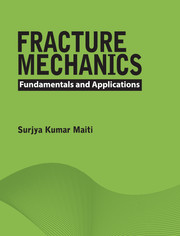Book contents
- Frontmatter
- Dedication
- Contents
- List of Figures
- List of Tables
- Preface
- 1 Introduction
- 2 Linear Elastic Fracture Mechanics
- 3 Determination of Crack-Tip Stress Field
- 4 Crack Opening Displacement, J Integral, and Resistance Curve
- 5 Determination of Stress Intensity Factors
- 6 Mixed Mode Brittle Fracture
- 7 Fatigue Crack Growth
- 8 Elastic Plastic Fracture Mechanics
- 9 Experimental Measurement of Fracture Tougness Data
- Index
- References
5 - Determination of Stress Intensity Factors
Published online by Cambridge University Press: 05 February 2016
- Frontmatter
- Dedication
- Contents
- List of Figures
- List of Tables
- Preface
- 1 Introduction
- 2 Linear Elastic Fracture Mechanics
- 3 Determination of Crack-Tip Stress Field
- 4 Crack Opening Displacement, J Integral, and Resistance Curve
- 5 Determination of Stress Intensity Factors
- 6 Mixed Mode Brittle Fracture
- 7 Fatigue Crack Growth
- 8 Elastic Plastic Fracture Mechanics
- 9 Experimental Measurement of Fracture Tougness Data
- Index
- References
Summary
Introduction
The stress intensity factor (SIF) plays the most pivotal role in the application of linear elastic fracture mechanics (LEFM) principles to practice. It is useful in the assessment of safety or reliability of a machine or structural component with a crack. It enables the calculation of crack growth rate through a component under fatigue loading, stress corrosion, etc. For the safety assessment, two things are needed: the SIF corresponding to the loading on component and the fracture toughness of its material. The latter is a material data obtained through experiment. The former is obtainable in some situations from handbooks of SIFs (Sih 1973a; Rooke and Cartwright 1976; Murakami et al. 1987; Tada, Paris and Irwin 2000), while in others it has to be determined using either an analytical method, or a numerical method, or an experimental technique. The analytical techniques include complex stress function based approaches, boundary collocation method, integral transform technique (Sneddon and Lowengrub 1969; Sneddon 1973), Green's function method, weight function method, etc. The numerical methods have been very widely employed for their versatility and capability for handling complex geometry easily. The three important numerical techniques are: finite element method (Wilson 1973; Atluri 1986), boundary element method (Aliabadi, Rooke and Cartwright 1987; Cruse 1996; Mukhopadhyay, Maiti and Kakodkar 2000; Rabczuk 2013), and meshless method (Belytschko et al. 1996; Atluri and Zhu 1998). The experimental techniques include strain gauge based method (Dally and Sanford 1987), photoelasticity (Kobayashi 1975; Dally and Riley 1991; Ramesh 2000), and method of caustics (Theocaris and Gdoutos 1976; Theocaris 1981; Rosakis and Zehnder 1985). A very good account of the analytical and finite element based methods is given in compilations by Sih (1973b) and Atluri (1986).
In this chapter, some important analytical methods, numerical technique based on finite element method, strain gauge based technique, and photoelasticity are only discussed.
Analytical Methods
In the analytical methods, the SIFs are calculated using the following relations for Mode I, II, and III, respectively, provided the crack-tip stress field is given in terms of r and θ.
In all these cases, origin is at the crack-tip. x axis (θ = 0) is aligned with the crack plane and it points towards the direction of crack extension (Fig. 5.1).
- Type
- Chapter
- Information
- Fracture MechanicsFundamentals and Applications, pp. 102 - 151Publisher: Cambridge University PressPrint publication year: 2015



